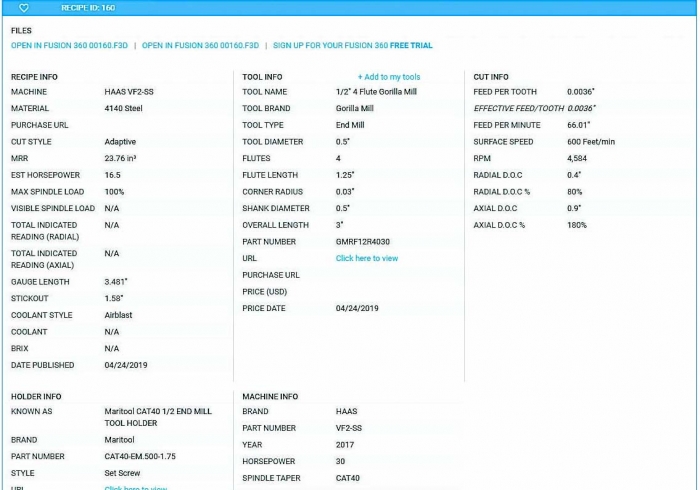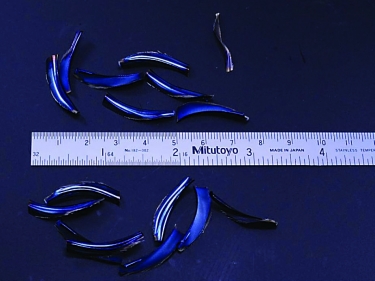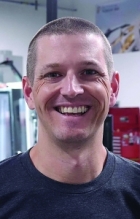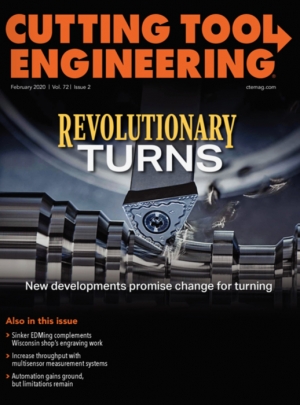Properly machining a part requires knowing the correct speeds and feed rates for a cutting tool and workpiece material — a skill that can take years to master. What if a resource existed that could make it possible for anyone to run a CNC machine and successfully cut a range of materials, from plastic and stainless steel to titanium? What if the same resource could help seasoned machinists learn how to optimize a new cutting tool or material?
More than a decade ago, I bought a benchtop CNC mill to develop a product. To improve the odds of my business succeeding, I needed to learn the basics of machining. But all the essentials, such as cutting tools and CAD/CAM software, were foreign topics to me. So I soaked up every resource I could find in the pre-YouTube era and fell in love with machining.

A partial recipe from ProvenCut. Images courtesy of J. Saunders
Each ProvenCut recipe includes, among other ingredients, a photo of the chips made during the cut
Countless aids since have emerged that shorten the learning curve for manufacturing entrepreneurs: affordable CAD/CAM software; YouTube channels dedicated to CNC machining, including my company’s own, NYC CNC; online and hands-on training classes; and the resurgence of manufacturing through reshoring and insourcing. Yet I have continued to see people struggle with speeds and feeds whether they are new to machining, working with a new material or trying to optimize a new cutting tool.
The machining world needed a modern solution for determining correct speeds and feeds — a solution that accounted for high-speed CAM toolpath strategies, current CNC machine capabilities and user-friendly, intelligent interfaces. The idea for ProvenCut was born. It would offer proven speeds and feeds backed by video tutorials and comprehensive machining and tool information.
Since launching ProvenCut last year, user response has been exceptional, with feedback ranging from “You saved me hours of testing a new tool for stainless steel” to “ProvenCut is like watching high-definition TV after spending your whole life reading plain text.”
Each ProvenCut recipe includes:
- Comprehensive cutting data, ranging from coolant and gauge length to horsepower.
- Video footage of the cut, allowing users to watch and listen as if standing next to a skilled machinist.
- Photographs of the cutting tool, the chips made during the cut and the machine setup.
- Links to purchase tools, toolholders and raw material.
- A link to automatically open the cutting tool and CAM operation in Fusion 360 software from Autodesk Inc.
ProvenCut recipes can be filtered by almost any machining criteria. Examples include the machine tool brand; gauge length; number of flutes on a tool; coolant type, such as flood, through the spindle, dry or near dry; machine horsepower; toolholder style; and tool type. The filter options are unparalleled in the speeds-and-feeds world when compared with resources like tool manufacturers’ starting recommendations, PDF guides and calculators.

Each ProvenCut recipe includes, among other ingredients, a photo of the chips made during the cut. Image courtesy of J. Saunders
Dimensional units may be switched from imperial to metric with a master toggle, or a simple mouse hover over any dimension will display the alternate unit. Recipes can be starred as favorites, and users can add cutting tools to their tool libraries to filter recipe results by cutting tools that they already own.
Recipes are created at Saunders Machine Works LLC, which operates over a dozen CNC machines that range from a FANUC Robodrill to a Haas UMC-750. Our experience running NYC CNC, a CNC YouTube channel with more than 300,000 subscribers, meant we knew how to film machines and had a great audience to help kick-start ProvenCut. ProvenCut also has worked with select partners to make recipes with machines, such as the popular Datron neo and high-end DMG Mori machines.
ProvenCut continually is expanding its CNC machines, recipes and materials, as well as adding different CNC machines, including lathes and turning centers, as we reduce barriers and allow anyone to succeed with CNC machining.
Related Glossary Terms
- centers
centers
Cone-shaped pins that support a workpiece by one or two ends during machining. The centers fit into holes drilled in the workpiece ends. Centers that turn with the workpiece are called “live” centers; those that do not are called “dead” centers.
- computer numerical control ( CNC)
computer numerical control ( CNC)
Microprocessor-based controller dedicated to a machine tool that permits the creation or modification of parts. Programmed numerical control activates the machine’s servos and spindle drives and controls the various machining operations. See DNC, direct numerical control; NC, numerical control.
- computer-aided manufacturing ( CAM)
computer-aided manufacturing ( CAM)
Use of computers to control machining and manufacturing processes.
- coolant
coolant
Fluid that reduces temperature buildup at the tool/workpiece interface during machining. Normally takes the form of a liquid such as soluble or chemical mixtures (semisynthetic, synthetic) but can be pressurized air or other gas. Because of water’s ability to absorb great quantities of heat, it is widely used as a coolant and vehicle for various cutting compounds, with the water-to-compound ratio varying with the machining task. See cutting fluid; semisynthetic cutting fluid; soluble-oil cutting fluid; synthetic cutting fluid.
- feed
feed
Rate of change of position of the tool as a whole, relative to the workpiece while cutting.
- flutes
flutes
Grooves and spaces in the body of a tool that permit chip removal from, and cutting-fluid application to, the point of cut.
- milling machine ( mill)
milling machine ( mill)
Runs endmills and arbor-mounted milling cutters. Features include a head with a spindle that drives the cutters; a column, knee and table that provide motion in the three Cartesian axes; and a base that supports the components and houses the cutting-fluid pump and reservoir. The work is mounted on the table and fed into the rotating cutter or endmill to accomplish the milling steps; vertical milling machines also feed endmills into the work by means of a spindle-mounted quill. Models range from small manual machines to big bed-type and duplex mills. All take one of three basic forms: vertical, horizontal or convertible horizontal/vertical. Vertical machines may be knee-type (the table is mounted on a knee that can be elevated) or bed-type (the table is securely supported and only moves horizontally). In general, horizontal machines are bigger and more powerful, while vertical machines are lighter but more versatile and easier to set up and operate.
- toolholder
toolholder
Secures a cutting tool during a machining operation. Basic types include block, cartridge, chuck, collet, fixed, modular, quick-change and rotating.
- toolpath( cutter path)
toolpath( cutter path)
2-D or 3-D path generated by program code or a CAM system and followed by tool when machining a part.
- turning
turning
Workpiece is held in a chuck, mounted on a face plate or secured between centers and rotated while a cutting tool, normally a single-point tool, is fed into it along its periphery or across its end or face. Takes the form of straight turning (cutting along the periphery of the workpiece); taper turning (creating a taper); step turning (turning different-size diameters on the same work); chamfering (beveling an edge or shoulder); facing (cutting on an end); turning threads (usually external but can be internal); roughing (high-volume metal removal); and finishing (final light cuts). Performed on lathes, turning centers, chucking machines, automatic screw machines and similar machines.


